SONGS OF SOCIAL PROTEST Part Two (Part one is HERE)
A number of songs on Dylan’s early albums engage with Civil Rights issues. Oxford Town is a short, slightly offhand piece written in a colloquial style. Its five short verses are performed over a sprightly accompaniment which Dylan himself described as a banjo tune played on the guitar. There is no chorus but the title phrase is used repeatedly. The last line of each verse provides a sardonic comment on the situation being described. It was originally written for Broadside in response to calls for songs about the controversy over the admission of James Meredith, a Black student, to the University of Mississippi. Meredith’s eventual Admission to the University broke down the colour bar at the University, despite the opposition of the State Governor. President Kennedy intervened in the case to ensure Meredith’s admission but riots orchestrated by white supremacists followed, in which two bystanders were killed. But unlike Phil Ochs’ Ballad of Oxford Mississippi, which relates a very literal account of the events, the song does not mention Meredith, the University or the Governor.

DYLAN AT THE MARCH FOR FREEDOM 1963
The narrator appears to be an ordinary citizen with little political awareness. Whether he is black or white is not revealed. He seems to have little knowledge of the political situation and may have just ‘gone down to Oxford Town’ by chance. Rather than lecturing us about the morality of racism or police violence, Dylan shows the horror of an ordinary, non political person in the face of racial conflict. All the narrator wants to do is avoid the rioting and the police response and get away from this place. He gives us an impressionistic description of the atmosphere in the town …Everybody’s got their heads bowed down/ Sun don’t shine above the ground… In the second verse he seems to be referring to Meredith …He went down to Oxford Town/ Guns and clubs followed him down/ All because his face was brown… is followed by …Come to the door, couldn’t get in/ All because of the colour of his skin… But the narrator does not express any anger. His reaction to the policy of segregation is merely to ask …What do you think about that, my friend?… After he tells us that …Me and my gal and my gal’s son… …We got met with a tear gas bomb… he merely shrugs …Don’t even know why we come/ We’re goin’ back to where we come from… In the final verse we hear that …Everybody’s singing a sorrowful tune/ Two men died ‘neath the Mississippi moon/ Somebody better investigate soon… but the narrator still sounds relatively cheerful. A couple of ironic references to popular romantic songs are even thrown in. Me and My Gal is a well known show tune from the musical and film of the same name, while Mississippi Moon is an old Jimmy Rodgers favourite.
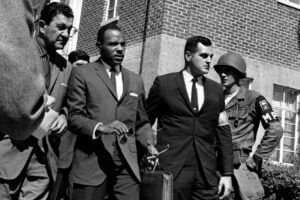
JAMES MEREDITH BEING ESCORTED BY OFFICIALS
In contrast to this relatively subtle approach, Only a Pawn in Their Game is an outspoken political polemic. The song was performed at a Voter registration rally in Greenwood Mississippi, at the Newport Folk Festival (both in July 1963) and at the March for Freedom in Washington (in August 1963) but has only been played a handful of times since. It focuses on the death of Medgar Evars, a leading Civil Rights activist who was murdered by Byron De La Beckwith, a white supremacist, who hid behind a bush near Evars’ home in order to commit the act. Beckwith was arrested for the crime but it took until 1994 for him to be finally convicted. Dylan’s approach to this case is radically different to what might be expected. Rather than condemning the murderer he castigates the entire culture of institutionalised racism that provides the context for such atrocities.
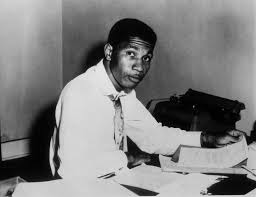
MEDGAR EVARS
The song is delivered over minimal guitar strumming, with the occasional interjection of harmonica in some live performances. All the emphasis is on the lyrics, which on the album are delivered in a particularly harsh monotone. The use of a changeable rhyme scheme and varying line lengths helps to keep listeners focused on the narrative, although in four of the five verses the same rhyme is used in the last five lines. This has the effect of drawing our attention to the final lines, with their rather unexpected assertions. The opening verse, which uses dramatic repetition and alliteration effectively, is perhaps the most poetic. The striking, alliterative opening …A bullet from the back of a bush/ Took Medgar Evans’ blood… is followed by three lines beginning with ‘A, in which Dylan provides ‘close ups’ of the murderer’s momentous actions. We are told that …A finger fired the trigger to his name…. then …A handle hit out in the dark/ A hand set the spark… Here we can almost hear the revolver clicking. The description suggests that the murder is almost an automatic action, as if the killer himself had no control over what he is doing. This is reiterated in …Two eyes took the aim/ Behind a man’s brain… which suggests that the ‘eyes’ were acting in a pre-programmed, robotic, way; as if the murderer was being controlled by some hidden force. This imagistic introduction sets up the theme of the polemic that Dylan will then deliver.
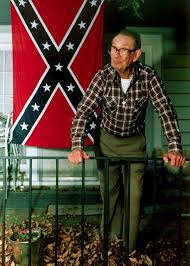
BYRON DE LA BECKWITH
Without doubt, the refrain: …But he can’t be blamed/ He’s only a pawn in their game… is shocking, in that it appears to avoid the standard condemnation of the killer. The metaphor of the killer being merely a ‘pawn’ is strengthened by the fact that chess pieces are, of course, always either black or white. Dylan tries, however, to avoid a simple ‘black and white’ approach. He appears to be quite prepared to challenge his audience – even the 250,000 gathered at the March on Washington, where the song was played – to consider the root causes of racism, rather than merely condemning an individual for his actions. This is an extremely laudable aim, displaying Dylan’s characteristic tendency to try to unsettle the assumptions of his audience. The assertion that …he can’t be blamed… was, however, controversial at the time and arguably remains so today. It is hard to categorise Byron Beckwith, who was a member of the Ku Klux Klan and an extreme right wing Christian organization which viewed Blacks as inferior, as any kind of ‘innocent’. In other songs, like Blowin’ in the Wind and Who Killed Davy Moore we are presented with unanswered or unanswerable questions and are thus allowed to come to our own conclusions. But here Dylan appears to be making this judgement for us. The song makes generalised – but extremely pertinent – points about the manipulation of poor whites. But whether Beckwith himself is a good example of someone who has being controlled in this way is open to question.

KU KLUX KLAN
The song is absolutely unstinting in exposing the venal, hypocritical nature of the forces that Dylan states are controlling the murderer. The one example of reported speech in the song is the blatantly racist voice of a Southern politician who tells the poor whites that …”You got more than the blacks, don’t complain/ You’re better than then, you’ve been born with white skin”… Eleven of the line endings in the second verse repeat the same rhyme, giving the narrator’s point extra heft. The short, pithy lines are delivered with a knowing cynicism, while the contrived repetition gives the impression of an unchanging and predictable pattern of bigotry: …And the Negro’s name/ Is used, it is plain/ For the politician’s gain/As he rises to fame… Meanwhile the poor white remains …on the caboose of the train… In the following verse Dylan names various prominent members of Southern society: …the deputy sheriffs, the soldiers, the governors… and the …marshals and cops… all of whom use the poor white man …like a tool… We are told that the poor white is taught throughout his life that …the laws are with him/ To protect his white skin… in order to distract him from his own disadvantaged situation.
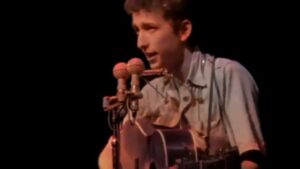
We then hear how the poor white man is …taught how to walk in a pack/ Shoot in the back… (as Beckwith did) …With his fist in a clinch/ To hang and to lynch/ To hide ‘neath the hood… (of the Klan) …to kill with no pain/ Like a dog on a chain… The piling of up of rhymes perhaps becomes a little strained here, but the following assertion that …he ain’t got no name… implies that any one of those brainwashed poor whites could have pulled that trigger and that Dylan is not giving Beckwith the luxury (and the free publicity) of actually using his name. Finally the scene shifts to Medgar Evans’ funeral. Dylan memorably tells us that …they lowered him down as a king… The song ends with Dylan imagining the unlikely scenario that the killer will end up with ‘Only a pawn in their game’ carved on his tombstone. In some ways, the song is perhaps a little heavy handed in the way it delivers its message, but its shifting of blame from the ’lone killer’ to the wider society makes a crucial point that, in the context of the vicious struggle of Civil Rights at the time, certainly needed to be made.
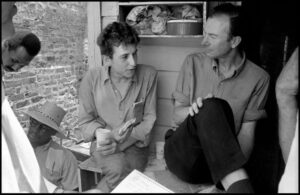
DYLAN AND PETE SEEGER
The Lonesome Death of Hattie Carroll Dylan is far more subtle in his approach, despite the song having a similar theme. While Only a Pawn deals with the murder of a well known figure, the story related in Hattie, which is again taken from a newspaper report, concerns the killing of a poor Black woman by a young, drunken racist. Hattie Carroll, a middle aged worker in a bar in Maryland, was struck repeatedly and racially abused by William Zantzinger, a wealthy young plantation owner, at a social gathering in Baltimore, Maryland in February 1963. She died later in hospital after having a stroke. The charge of murder was downgraded to manslaughter and Zantzinger received a mere six month sentence. His imprisonment was even delayed until after he had supervised the tobacco harvest. He later claimed publically that the song had painted a wholly inaccurate picture of what had occurred. But Dylan’s intention is clearly to use the song to make a generalised comment on the state of American justice. In the typical manner of topical song writers, he moulds the story and exaggerates certain elements in order to deliver his message.

The song combines Dylan’s Guthriesque concern with social justice with a Brechtian dramatic focus and a number of extremely resonant poetic flourishes, to create a work whose power remains undiminished with the passing of years. It became one of Dylan’s best known and most performed songs, being played around 200 times between 1964 and 2012. On the Rolling Thunder Tour and in numerous subsequent iterations it was given a full band arrangement. A number of cover versions have also appeared, by Judy Collins, Christy Moore, Julie Felix, Martin Carthy and others. The melody is an adaptation of the stately Scottish ballad Mary Hamilton, which relates how a woman murders her baby, although the arrangement is considerably more frenetic. Another model for the song is Brecht’s The Infanticide of Marie Farrar, which has a similar theme and which, like Hattie Carroll, places the murder in a social context. While Only a Pawn makes a point of not naming the murderer, here Dylan puts considerable emphasis on his name, mentioning it five times. There is certainly no suggestion that ‘he ain’t to blame’. Zanzinger (as Dylan renames him) is not a poor white but a rich farmer with inherited wealth.

HATTIE CARROLL
As the story unfolds, the intensity of the narrative voice increases. The first two verses give fairly straightforward accounts, whereas in verses three and four the song becomes more passionate and poetic. Verses one and two have seven lines, while verses three and four have eleven. It is as if the storyteller has begun by trying to remain calm and detached. But because of the horror of the events, he becomes progressively angrier. The chorus is repeated identically three times before the final devastatingly ironic twist after verse four. The song also juxtaposes poetic techniques with colloquial language in a highly effective way, moving seamlessly from some quite beautiful poetic expressions to forceful, if ungrammatical, declarations.
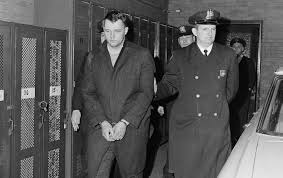
WILLIAM ZANTZINGER
The song begins abruptly without a musical intro, as voice and guitar start up in unison:…William Zanzinger killed poor Hattie Carroll/ With a cane that he twirled around his diamond-ring finger… The first line is a simple statement, but the second has the distinct sense of poetic movement that characterises much of the song. We now see the murder implement in motion, as if Zanzinger is some kind of evil magician. The description of Zanzinger as having a ‘diamond ring finger’ (as opposed to him ‘wearing a diamond ring’ or ‘having a diamond ring on his finger’) is a brilliantly compressed way of showing him to be a person whose wealth and privilege is literally part of his identity. The phrase seems to suggest that the ring is actually part of his finger, a ‘natural’ addition to his physiognomy. The lines are so resonant that we can almost see the flashing of the ring (representing the flaunting of his ‘superior’ status) as he ‘twirls’ that cane. The rest of the verse is, in deliberate contrast, flatly prosaic. We hear that this incident happened at a ‘society gathering’ in Baltimore, and that after the murder Zanzinger is arrested and taken to the police station, where he is charged with ‘first degree murder’.

Such an abrupt account is unusual for murder ballads, which usually build up to the revelation of the crime. But the song will not be a mere account of the murder. The chorus runs …But you who philosophize disgrace and criticize all fears/ Take the rag away from your face, now ain’t the time for your tears… These lines epitomize the way the song constantly shifts between ‘intellectual’ and ‘everyday’ language, which itself reflects the social gulf between the protagonists. The identity of people who ‘philosophize disgrace’ is rather ambiguous. If the word ‘philosophize’ is used in a pejorative way, this may refer to Zanzinger’s family or his supporters, who merely sweep away the moral implications of his crime. Or it may refer to liberal intellectuals who, despite their public protestations of anti-racism, do not understand the real physical and moral implications of the effects of racism itself. The use of ‘rag’, rather than ‘handkerchief’ scathingly suggests that the implement they will use to wipe away their tears is merely a cheap piece of ‘throwaway’ material.
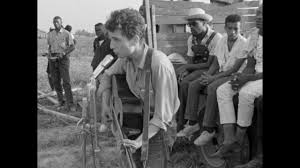
The second verse, which is concerned entirely with Zanzinger, begins with a short summary of his status: …William Zanzinger, who at twenty four years/ Owns a tobacco farm of six hundred acres/ With rich wealthy parents who provide and protect him… We now know, if we had not already guessed, that he is from a highly privileged background. With the ‘double positive’ of ‘rich wealthy’ Dylan again slips into colloquial English. It is as if we are hearing a relatively uneducated person outlining the fact that Zanzinger is actually very wealthy. This is the kind of intimate linguistic trick that would become commonplace in Dylan’s songs of 1965-66 and beyond. Then the lines begin to take on a strange, if ungrammatical, motion of their own, just like that ‘cane twirling round a finger’. We hear that …High office relations in the politics of Maryland/ Reacted to his deed with a shrug of their shoulders/ And swear words and sneering and his tongue it was a-snarling/ And in a matter of minutes on bail was out walking… The first two lines refer to Zanzinger’s relations and the last two are about Zanzinger himself. But it is not immediately obvious who is doing the ‘swear words and sneering’. At first it seems as if this refers to the rich relatives. The implication seems to be that Zanzinger is merely mouthing the words that his relatives would say. This further shows us that he is the product of his privileged background. The use of alliteration here, contrasting the ‘s’ sounds of ‘shrug of his shoulders’ and ‘swear words and sneering’ with the ‘m’ sounds of a ‘matter of minutes’, is especially effective.
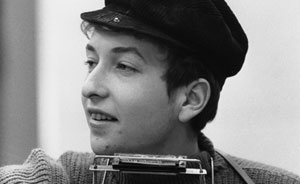
In the third verse, the song reaches even greater poetic heights and does so by taking great liberties with the ballad form itself. Dylan delivers an entire eleven line verse without any actual rhymes at the end of the lines. We are given a potted biography of the victim, beginning with the simple statement that …Hattie Carroll was a maid of the kitchen/ She was fifty one years old and gave birth to ten children… This immediately gives us a clear picture of the difference between Hattie and Zanzinger. One of the brilliant coups of the song is that it never actually states that Hattie is black (or that Zanzinger is white) as the context Dylan provides makes this obvious. But this lack of racial identification (in a song about a racist murder) avoids the trap of constantly describing Black people’s victimhood. In the song, both main characters are merely human.
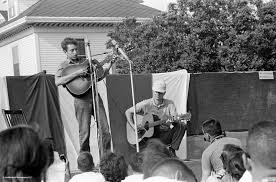
Another grammatical shift follows, again moving the song from mere description into motion. Hattie is the one …Who carried the dishes and put out the garbage… While the identical number of syllables in the words at the end of the first two lines, ‘kitchen’ and ‘children’, are suggestive of rhyme, the word ‘garbage’ stands out a mile; the hidden suggestion being that she is treated like ‘garbage’. Dylan then follows this with …And never sat once at the head of the table/ Who just cleaned up all the food from the table/ And who didn’t even talk to the people at the table… The repetition of ‘table’ has the effect of giving us a vivid impression of the sheer drudgery of her life. The table becomes a symbol of the social distance between her and her social ‘superiors’. This is followed by the clever punning of …And emptied the ashtrays on a whole other level… The demeaning act of ‘emptying the ashtrays’ is carried out on a different physical ‘level’ to that table. Obviously Hattie will empty them into a bin on a ‘lower level’. At the same time her entire life is being lived on a ‘different level’ to her employers and those she serves.

Dylan then gives us two of the most memorable and resonant lines in his entire oeuvre. Having established the momentum of describing Hattie’s actions, using the active construction of …Who…who…, we now begin with the active verb ‘got’. We hear that Hattie …Got killed by a blow, lay slain by a cane/ That sailed through the air and came down through the room… The internal rhyme of ‘slain/cane’ stands out here because it is the only rhyme in the entire verse. The phrase ‘slain by a cane’, if seen as a pun, evokes the Biblical murder of Abel by his brother Cain which, according to the Bible, was the first murder of all. This suggests that the murder of Hattie represents all the cruel and unnecessary violence that humans have imposed on each other throughout time. The second line takes us back to the action of the first verse but now presents it from her point of view, as if she is now watching the horrific moment of her death unfold in agonising slow motion. Then we get the pronounced alliteration of …doomed and determined to destroy all the gentle… wherein the three ‘d’ words, all signifying destruction and cruelty, are juxtaposed against the single word ‘gentle’, which summarises Hattie’s character. This is followed by a quintessentially Dylanesque double negative, which again sets the poetic language of the rest of the verse against a very clear and angry statement, delivered in the kind of words Hattie herself might have used: …And she never done nothing… Dylan tells us …to William Zanzinger…
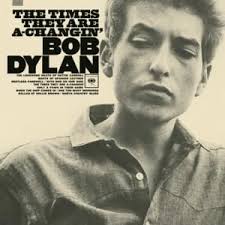
The final verse takes us into the courtroom, beginning with an extended ironic description of the corrupt legal system. Dylan uses ‘and’ repetitively here in a way that enhances the irony, as if the descriptions are matter of fact statements. We are told that …In the courtroom of honor, the judge pounded his gavel / To show that all’s equal and that the courts are on the level … But of course there is no real ‘honour’ here. We are told that …And that the strings in the books ain’t pulled and persuaded/ And that even the nobles get properly handled/ Once that the cops have chased after and caught ‘em/ And that the ladder of law has no top and no bottom… There is an odd mixed metaphor here of ‘strings’ and ‘books’, as well as the rather archaic (in the American context) reference to ‘nobles’. The language seems to mimic the reactions of Hattie’s family or supporters. Then we get another grammatical shift: …Stared at the person who killed for no reason/ Who just happened to be feeling that way without warning… It is obvious that it is the judge who is doing the ‘staring’. We hear that he …spoke through his cloak, most deep and distinguished… The metaphorical ‘cloak’ represents not only the judge’s status and position but the way he will soon place a ‘cloak’ over the principles of justice. The alliteration of ‘deep and distinguished’ parallels the earlier use of ‘doomed and determined’.

Dylan then delivers the denouement, finally using a conventional rhyme: …And handed out strongly for penalty and repentance/ William Zanzinger, with a six month sentence… Given the build up, it cannot really be said that this is a surprise. The relatively trivial punishment handed to Zanzinger is clearly a product of the corrupt and racist judicial system. The ironic presentation of this and the changed lines in the final chorus …Bury the rag deep in your face/ Now’s the time for your tears… makes the intended meaningyy absolutely clear. The song is, like Only a Pawn or Emmett Till, a castigation of the American social system. But its sustained rhetorical structure, its mixing of colloquial and poetic discourses and the perfectly paced delivery of its ironic conclusion convey a similar message in a far more powerful way.
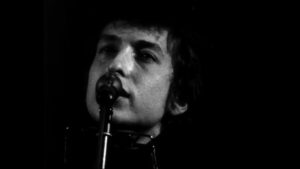
Hattie Carroll can be seen as a culmination of Dylan’s ‘protest phase’. While it still contains the Guthriesque concern with relative social justice, its use of language predicts the move into symbolist poetry that will dominate the next phase of Dylan’s career. Its portrayal of character is clear and delineated, with the characters themselves being emblematic of a highly unequal social system in which racism is institutionised. If there is one overarching target of Dylan’s protest songs, however, it is not war or social injustice but the hypocrisy of those who control others in society for their own ends but pretend to be fair and just. Here he nails that hypocrisy with a precise and unerring aim. In little more than two years he had established himself, at the age of only twenty three, as (in a commonly used phrase that he himself despised but was in fact very accurate) the ‘voice of his generation’. No other song writer, poet or prose writer gave voice to the concerns of people of his age about a society still trapped in the racist assumptions of the past or a world which was apparently teetering unsteadily on the edge of destruction. Although he would soon move on to pastures now, he left behind him a considerable legacy of protest songs, the best of which spoke in a language which belied their origins in the era of the early 1960s and spoke universal truths in a way that is still relevant today and will, perhaps sadly, continue to be so for the foreseeable future.


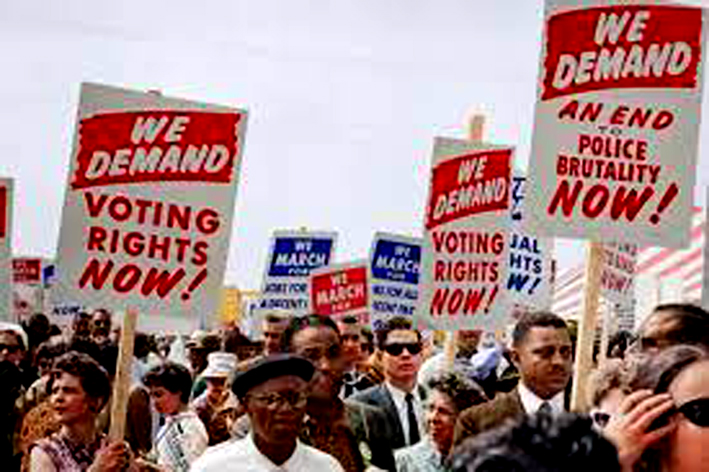
Leave a Reply